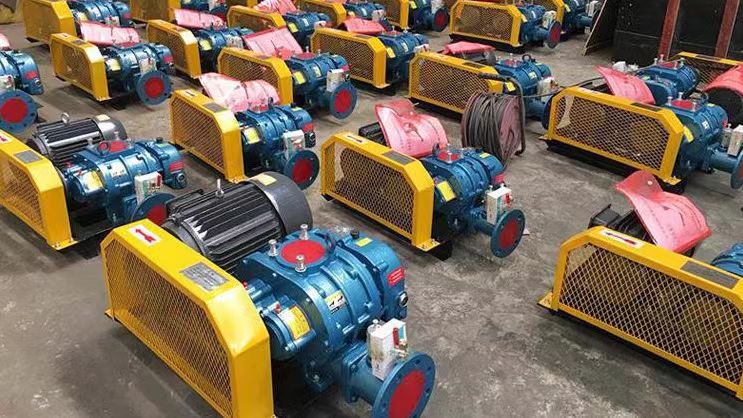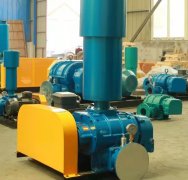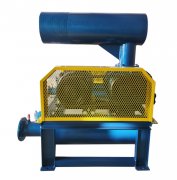Comprehensive Comparative Analysis of Maglev Fan and Roots Fan
In the modern industrial field, magnetic levitation fans and Roots blowers are common gas conveying equipment, and there are significant differences between the two in terms of working principles, performance characteristics, and application scenarios. Understanding these differences can help users make appropriate choices based on their actual needs.
The essential difference in working principle
The magnetic levitation fan adopts advanced magnetic levitation bearing technology, which suspends the rotor in the air through electromagnetic force to achieve contactless transmission. This technology relies mainly on electrical control systems to maintain rotor stability through mechanical friction. The core lies in using magnetic force to replace traditional mechanical support structures and achieve free suspension of the rotor.
Roots blower belongs to positive displacement blower, which relies on two interlocked rotors rotating in the opposite direction inside the casing to transport gas. Maintain micrometer level precision clearances between rotors and between rotors and casings, and ensure rotational accuracy through synchronous gears. This mechanical contact working mechanism determines its different performance characteristics.
Comparison of Energy Efficiency Performance
In terms of energy efficiency, magnetic levitation fans have shown significant advantages. Due to its frictionless design, energy loss is significantly reduced, and overall efficiency is typically 20-40 higher than that of Roots fans. Especially with the installation of permanent magnet motors and intelligent control systems, the speed can be automatically adjusted according to load changes, achieving energy-efficient operation.
The efficiency of Roots blower is relatively low, and the main energy loss comes from mechanical friction and clearance leakage. Although optimizing the rotor profile can improve efficiency, the space for energy efficiency improvement is limited by the working principle. In situations where long-term continuous operation is required, this energy efficiency difference can lead to significant differences in operating costs.
Maintain demand differences
The maintenance workload of magnetic levitation fans is relatively small. Due to the contactless design, there is no need to replace vulnerable parts such as bearings and gears, nor is there a need for lubricating oil maintenance. The main maintenance work is focused on the electrical and control systems, requiring professional personnel to use specialized equipment for testing and maintenance.
Roots blowers require regular maintenance. Gear lubricating oil needs to be replaced on time, bearings and seals have limited service life, and rotor clearance needs to be checked and adjusted regularly. These maintenance tasks, although relatively simple, require downtime and can affect equipment efficiency. In harsh working conditions, the maintenance cycle needs to be correspondingly shortened.
Noise and vibration control
Magnetic levitation fans have significant advantages in noise control. The design without mechanical contact fundamentally addresses the source of mechanical noise, and with optimized airflow channel design, the overall noise level is 10-15 decibels lower than that of Roots fans. Meanwhile, the magnetic levitation system can effectively suppress vibrations and provide a smoother operating state.
The noise of Roots blower mainly comes from airflow pulsation and mechanical transmission. Although it can be reduced by installing mufflers, the effect is limited. Vibration control relies on basic vibration reduction devices, which can still produce significant vibrations during high-speed operation. This raises higher standards for noise and vibration requirements in the installation environment.
Initial investment cost
The high technological content of magnetic levitation fans results in significantly higher initial investment costs compared to Roots fans. The manufacturing cost of core components such as magnetic bearings and control systems is relatively high, and installation and debugging also require the participation of professional technical personnel. This investment difference is particularly evident in small equipment.
The manufacturing technology of Roots blower is mature and the industrial chain is complete, so the cost is relatively low. Its simple mechanical structure also reduces manufacturing difficulty, making the equipment more cost-effective. For users with limited budgets or who do not require high performance, this is an important consideration.
Applicable scenario analysis
Magnetic levitation fans are particularly suitable for situations that require high energy consumption, noise, and reliability. The energy-saving effect is significant in sewage treatment plants that require continuous operation; Low noise characteristics are particularly important in quiet areas such as hospitals and schools; In the field of precision manufacturing, oil-free design can ensure air purity.
Roots blowers are more suitable for general industrial applications. Its sturdy structure is suitable for harsh environments, simple maintenance is suitable for users with weaker technical capabilities, and lower investment is suitable for projects with limited budgets. It still has practical value in small and medium-sized pneumatic conveying systems, ordinary aeration applications, etc.
Outlook on Development Trends
With the advancement of technology, the cost of magnetic levitation fans is gradually decreasing and their performance is constantly improving. The application of intelligent control systems makes it more reliable. And the Roots blower is also constantly improving, with the application of new materials extending its service life and optimizing design improving efficiency. Both devices are developing towards greater energy efficiency and reliability.
Users should consider actual needs, budget constraints, and long-term operating costs when making choices. For projects that focus on energy efficiency and environmental protection, magnetic levitation fans are a better choice; For general industrial applications, Roots blowers still have their unique value. The correct equipment selection is one of the key factors to ensure the success of the project.



